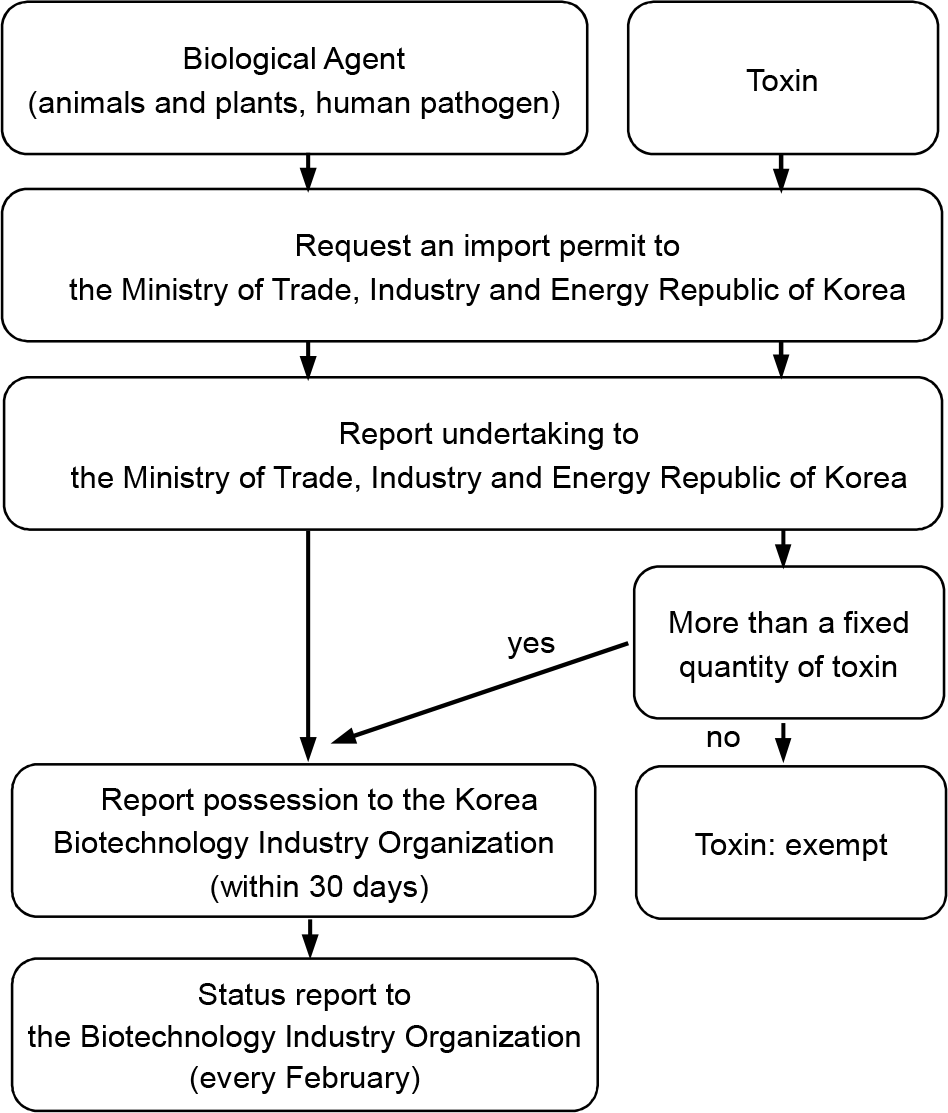Abstract
The Laboratories engaging with microorganisms have some potential risks, depending on handling of pathogens. The safety management system to extend recognition of biosafety and biosecurity needs to be established and practiced in order to prevent hazard possibility and secure safety of researchers who deal with pathogen. As the importance and regulation of global biosafety and biosecurity tended to be intensified, various laws and institutions for the security of biosafety were established when the Act on implementation of Living Modified Organisms, an implantation act of Cartagena was enforced in Korea in 2008. In particular, the system of permission report for Living Modified Organism (LMO), Highly Dangerous Pathogens (HDPs) and Biological Weapons Convention (BWC), in order to prevent intended or non-intended leakage and occurrence of biohazard derived from pathogen and infectious substance and safely use them. The bioterrorism can be controlled and autonomous management of biosafety by agencies that handle pathogens can be also secured by practicing the various laws and institutions.
Go to : 
REFERENCES
1). Martini GA, Schmidt HA. Spermatogenic transmission of the “Marburg virus”. (Causes of “Marburg simian disease”). Klin Wochenschr. 1968; 46:398–400.
2). Oliphant JW, Parker RR. Q fever; Three cases of laboratory infection. Public Health Rep. 1948; 63:1364–70.

4). Holmes GP, Hilliard JK, Klontz KC, Rupert AH, Schindler CM, Parrish E, et al. B virus (Herpesvirus simiae) infection in humans: epidemiologic investigation of a cluster. Ann Intern Med. 1990; 112:833–9.

5). Barton Behravesh C, Mody RK, Jungk J, Gaul L, Redd JT, Chen S, et al. 2008 outbreak of Salmonella Saintpaul infections associated with raw produce. N Engl J Med. 2011; 364:918–27.

6). Chong PY, Chui P, Ling AE, Franks TJ, Tai DY, Leo YS, et al. Analysis of deaths during the severe acute respiratory syndrome (SARS) epidemic in Singapore: challenges in determining a SARS diagnosis. Arch Pathol Lab Med. 2004; 128:195–204.

7). Koh D, Sng J. Lessons from the past: perspectives on severe acute respiratory syndrome. Asia Pac J Public Health. 2010; 22:32S–6S.

8). Jiang TJ, Zhou XZ, Zhao M, Zhou ZP, Jiang SC, Ye WH, et al. Analysis of severe acute respiratory syndrome in Beijing. Zhonghua Nei Ke Za Zhi. 2003; 42:369–72.
9). Orellana C. Laboratory-acquired SARS raises worries on biosafety. Lancet Infect Dis. 2004; 4:64.

10). Lee KM, Nam HY, Shin SH, Choi MK, Choi YJ, Kwon SH, et al. A Survey on Laboratory Biosafety Status of Public Healthcare Centers in Korea. J Bacteriol Virol. 2013; 43:217–28.

11). U.S. Department of Health & Human Services, Center for Disease Control and Prevention, National Institutes of Health. Biosafety in Microbiological and Biomedical Laboratories (BMBL). 5th ed.Washington D.C.: CDC/NIH;2009. Available from: URL:. http://www.cdc.gov/biosafety/publications/bmbl5/BMBL.pdf.
12). World Health Organization. Laboratory biosafety manual. 3rd ed.Geneva: World Health Organization;2004. Available from: URL:. http://www.who.int/csr/resources/publications/biosafety/Biosafety7.pdf.
13). Cho A, Seok SH. Ethical Guidelines for Use of Experimental Animals in Biomedical Research. J Bacteriol Virol. 2013; 43:18–26.

14). Convention on Biological Diversity. http://www.cbd.int.
Go to : 
Table 1.
Summary of recommended biosafety level (BL)a
| Risk level | Biosafety level | Laboratory practices | Safety equipment and facilitues |
|---|---|---|---|
| 1 | BL1 | • Standard microbiological practices | |
| 2 | BL2 |
|
|
| 3 | BL3 |
|
|
| 4 | BL4 |
Table 2.
The reporting obligation as and living modified organisms and facility
| Classification | Submission | Type | |
|---|---|---|---|
| Imports and exports of LMOa | Recognition of state in the LMO for experimental & research | KCDCb | Approval |
| LMO for experimental & research | MSIPc | Declaration | |
|
BL1, 2 for human health risk BL1, 2 for environmental health risk |
MSIPc Central administrative agency concerned |
Declaration | |
| Facility for LMOa | BL3, 4 for human health risk | KCDCb | Permission |
| BL3, 4 for environmental health risk | MSIPc | Permission | |
| LMO of High-risk to human health | KCDCb | Approval | |
| Development and experimental of LMOa | Reserch for release into the environment, etc. |
MSIPc Central administrative agency concerned |
Approval |
Table 3.
General biosafety rule for laboratory usersa
Table 4.
The Highly dangerous pathogens in Korea




 PDF
PDF ePub
ePub Citation
Citation Print
Print



 XML Download
XML Download